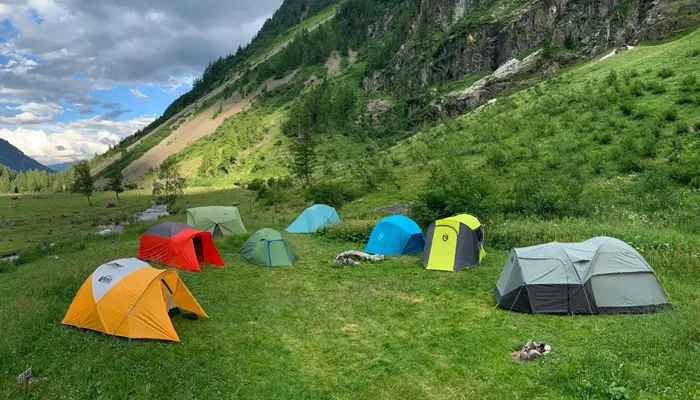When shopping for a tent, you’ll often see numbers like 1500mm, 3000mm, or even 10000mm used to describe waterproofness. But what do these numbers really mean? Let’s break it down simply.
What Does 1500mm Waterproof Mean?
The “mm” in 1500mm refers to millimeters of water. It’s measured through a hydrostatic head test where a tube of water is placed over the tent fabric. The number tells you how high the water column can be before water starts leaking through. So, 1500mm means the fabric can withstand a 1.5-meter (about 5 feet) column of water before leaking.
How Waterproof is 1500mm Really?
Here’s how to understand different waterproof ratings:
- 0-1000mm: Not waterproof, only water-resistant
- 1000-2000mm: Light rain protection
- 2000-3000mm: Moderate rain protection
- 3000mm+: Heavy rain protection
A 1500mm rating sits at the lower end of waterproof tents. It can handle light to moderate rain but might struggle in heavy downpours or prolonged wet conditions.
Pros and Cons of a 1500mm Waterproof Tent
Advantages of 1500mm Tents
- Lighter Weight: Lower waterproof ratings usually mean lighter fabric
- Better Breathability: Less waterproofing often means better airflow
- Lower Cost: These tents are typically more affordable
- Good for Fair Weather: Perfect for summer camping with occasional showers
Limitations of 1500mm Tents
- Not for Heavy Rain: May leak in sustained heavy rainfall
- Durability Concerns: May not last as long in wet conditions
- Condensation Issues: While more breathable, can still get damp inside
- Not for Extreme Weather: Not suitable for storms or harsh conditions
When to Choose a 1500mm Waterproof Tent
Ideal Conditions for 1500mm Tents
- Summer camping trips
- Camping in dry climates with occasional rain
- Short-term camping (weekend trips)
- When weight is a priority (backpacking)
- When you’re on a tight budget
When to Avoid 1500mm Tents
- Camping in rainy seasons
- Multi-day trips in wet climates
- Cold weather camping (where rain might turn to snow)
- When you need maximum reliability
- Family camping where staying dry is crucial
Comparing 1500mm to Other Waterproof Ratings
1500mm vs 3000mm Tents
A 3000mm tent offers twice the waterproof protection of a 1500mm tent. While heavier and less breathable, it provides:
- Better protection in heavy rain
- More durability in wet conditions
- Greater peace of mind for longer trips
1500mm vs 5000mm+ Tents
High-end tents with 5000mm or more are:
- Much heavier
- Less breathable
- More expensive
- Better for extreme conditions
- Often used for mountaineering or winter camping
How to Improve a 1500mm Tent’s Waterproofing
If you already own a 1500mm tent or find a great deal on one, there are ways to boost its waterproofing:
Use a Waterproof Spray
Products like Nikwax TX.Direct can add extra waterproofing. Apply it to:
- The rainfly
- Tent floor
- Seams (though seam sealing is better for seams)
Add a Footprint
A ground cloth underneath protects the tent floor from:
- Ground moisture
- Abrasion
- Punctures
Proper Setup Techniques
- Pitch the tent taut to prevent water pooling
- Use all guy lines for stability in wind
- Angle the tent to shed water effectively
- Avoid touching the walls when wet (causes leaks)
Add a Tarp Overhead
A simple tarp setup above your tent provides:
- Extra rain protection
- Shade from sun
- A dry entry/exit area
Real-World Performance of 1500mm Tents
User Experiences
Many campers report:
- Fine performance in light rain
- Occasional leaks in heavy storms
- Good durability if cared for properly
- Better performance when combined with a footprint
Professional Reviews
Outdoor gear testers often find:
- 1500mm is the minimum acceptable for camping
- Works well for fair-weather campers
- Not reliable for serious backpacking in wet climates
- Seam sealing is crucial at this rating
Key Features to Look for in a 1500mm Tent
If you decide a 1500mm tent fits your needs, look for these features to maximize performance:
Full-Coverage Rainfly
A rainfly that reaches close to the ground offers better protection than a partial fly.
Taped Seams
At 1500mm, taped seams are essential to prevent leaks at stitch holes.
Bathtub Floor
A floor that curves up the sides (like a bathtub) prevents ground water from seeping in.
Quality Zippers
Look for waterproof zippers or storm flaps to keep water out of openings.
Ventilation
Good airflow reduces condensation, which is important in less waterproof tents.
Maintenance Tips for 1500mm Tents
Proper care can extend the life and performance of your tent:
Cleaning
- Use mild soap and soft brush
- Never machine wash
- Rinse thoroughly
Drying
- Always dry completely before storage
- Hang in shade to prevent UV damage
- Avoid high heat
Storage
- Store loosely in a cool, dry place
- Never store compressed for long periods
- Keep away from sharp objects
Alternatives to 1500mm Tents
If you’re unsure about 1500mm, consider these options:
Hybrid Approach
Use a 1500mm tent with:
- Extra tarps
- Waterproof bivy inside
- Quality sleeping bag cover
Rent Before You Buy
Try different waterproof ratings to see what works for your needs.
Seasonal Tents
Have different tents for:
- Summer (1500mm)
- Shoulder seasons (3000mm+)
- Winter (4-season tents)
Conclusion
A 1500mm waterproof tent can be a good choice if:
- You mostly camp in fair weather
- Weight is a priority
- You’re on a budget
- You’re willing to take extra precautions in rain
However, for serious campers or those in wet climates, investing in a higher waterproof rating (3000mm+) is often worth the extra cost and weight.
Remember, no tent is completely waterproof forever. All tents require proper care and occasional re-waterproofing to maintain their performance over time.
The best tent is the one that matches your specific camping needs, budget, and willingness to maintain it. A 1500mm tent might be perfect for some campers, while others may need something more robust. Consider your typical camping conditions and choose accordingly.


